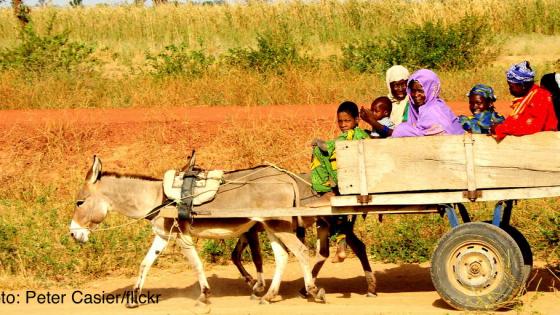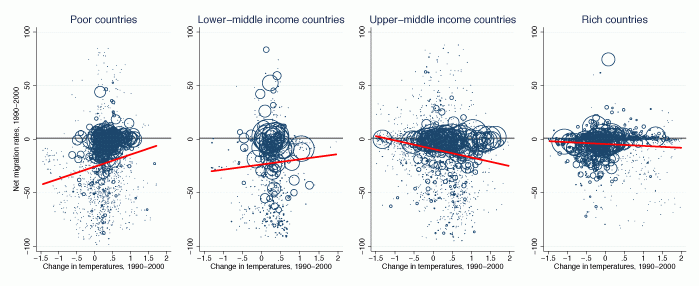The annual average temperature is projected to increase by up to 4° Celsius in the coming century (World Bank, 2018). Rising temperatures have been shown to influence various aspects of our economies, including GDP growth (Dell et al. 2012), local conflicts (Bosetti et al. 2018), mortality (Burgess et al. 2014), and agricultural and non-agricultural productions (Burke et al. 2015, Garcia-Verdu et al. 2019). Given the economic effects of weather shocks, we can expect the rise in temperatures to significantly affect migration patterns. The goal of this column is to provide new insight on expected migration responses to climate change by exploiting historical variations in temperatures and migrations.
Net migration rates at the grid cell level
We employ grid cell level data at the 0.5 x 0.5 degree resolution, where one grid cell covers the area of 56 km x 56 km at the equator for three decades: 1970-1980, 1980-1990, and 1990-2000. Decennial net migrations (the number of in-migrants minus the number of out-migrants) come from de Sherbinin et al. (2015) and population data are obtained from Yamagata and Murakami (2015). We define net migration rates by dividing net migration during the decade by the population at the beginning of the decade. Figure 1 shows a map of Europe describing net migrations during the 1990s. Red-coloured cells indicate positive net migration rates (meaning that in-migrations were greater than out-migrations) while blue cells indicate negative net migration rates.
Figure 1 Net migrations in Europe, 1990-2000
Notes: Map from de Sherbinin et al. (2015).
We explore mobility patterns by classifying countries using income level and grouping cells by population density within each country. Countries are separated into four groups (poor, lower-middle income, upper-middle income, and rich) based on the 25th, 50th, and 75th percentiles of income distribution. Spatial cells in each country are also separated into four groups (rural, mid-rural, mid-urban, and urban) based on the 25th, 50th, and 75th percentiles of population density distribution.
Figure 2 describes the net migration rates for each of the 16 groups. A grey band – 95% confidence interval – connects the net migration rates for each group of countries across cell density to allow easier visualisation of some patterns. First, it shows a clear internal migration pattern. – net migration rates are negative in rural, low-density areas (left side of the graph), and positive in urban areas (right side). This suggests that people have moved out of rural and semi-rural regions into urban and semi-urban ones.
Second, it shows that the gradient (intensity) of rural-urban migration – the slope of the line connecting net migration rates – is steeper in lower-middle-income countries, somewhat flatter in poor countries, and flattest in rich countries. These differences suggest that rural-to-urban migration is most intense in middle-income countries. Poor countries do not experience such large rural-urban migration because economic transition and urbanisation have not fully commenced. These observations are in line with international migration patterns documented by Clemens (2014) and Dao et al. (2018).
Figure 2 Average net migration rates by region and by income group of countries
Notes: Figure from Peri and Sasahara (2019). Grey bands indicate 95% confidence intervals.
Rising temperatures and net migration rates
We then examine the impact of decennial changes in annual average temperatures on net migration patterns. Figure 3 shows scatter plots taking the decadal net migration rates in rural (lowest density) cells during the period 1990-2000 on the vertical axis, and temperature changes in the same period on the horizontal axis. We present four scatter plots for the four income groups.
In Figure 3, higher temperatures are associated with higher net migration rates in poor countries. As net migration rates are mostly negative in rural areas (out-migration prevails), this positive association suggests that higher temperatures work to reduce out-migrations from rural areas. Our central estimates indicate that a 1° Celsius rise in annual average temperatures decreases the net out-migration rates by about 5 percentage points in rural areas of poor countries.
In contrast, the third panel shows that higher temperatures lead to lower net migration rates in upper-middle income countries. Again, all observations come from rural areas of the countries where net migration rates are mostly negative, implying that higher temperatures induce larger out-migration rates from rural areas. Our results indicate that a 1° Celsius rise in temperatures increases the net out-migration rates by 1.5 percentage points in rural areas of middle-income countries.
The slope of the fitted line for lower-middle income countries is somewhere between the poor and the upper-middle income group of countries, presumably because this group includes countries that are in the middle of transitioning from the poor to the upper-middle income level. Rich countries have almost zero slope, consistent with previous results that economic development makes countries less sensitive to climate (e.g. Dell et al. 2012).
Figure 3 The relationship between net migration rates and decennial changes in average temperatures for rural regions
Notes: Figure from Peri and Sasahara (2019). The scatter plots use grid cell-level observations from the country’s rural areas during the period 1990-2000. The size of the bubbles measure population in each grid cell.
A similar result is found using country-level data in Figure 4, which shows the relationship between out-migrations from rural areas as a share of total population in that country, and decennial changes in annual average temperatures. The scatter plots, which represent separately poor, lower-middle-income, and upper-middle-income countries, show that higher temperatures are associated with lower rural out-migrations in poor countries, and with greater rural out-migrations in upper-middle income countries.
To summarise, rising temperatures have asymmetric effects across countries, depending on income level. In middle-income countries, higher temperatures increase rural-to-urban migrations, inducing urbanization. In poor countries, higher temperatures have the opposite effect.
Figure 4 The relationship between out-migration rates and decennial changes in average temperatures, grouped by income of countries
Notes: Figure from Peri and Sasahara (2019). The scatter plots use country-level observations during the period 1990-2000. The vertical axis measures the share of out-migrations from rural areas against the total population of that country. The horizontal axis marks decennial changes in average temperatures.
Possible mechanisms
A simple model with rural-urban income differentials and migration costs can explain the asymmetric migration responses across countries. The model consists of two regions, rural and urban. The rural region specialises in agriculture while the urban area produces non-agricultural goods and services. Rural income is lower than urban productivity, which provides an incentive to migrate to the urban region (the incentive condition). But to pay migration costs, individuals need an income above subsistence (the feasibility condition). Hence, migrations occur when the rural income is low – producing incentive to migrate – but not so low as to make the feasibility condition binding.
We assume that higher temperatures reduce rural agricultural income but have no effect on urban productivity. If a temperature shock hits and the rural income level declines, the incentive to migrate to the urban region increases but the feasibility constraint becomes tight. These two changes affect migration flows differently depending on whether the feasibility constraint is binding. In a poor country where the feasibility constraint is binding, decreased agricultural income reduces rural-to-urban migrations. On the other hand, in a middle-income county where the feasibility constraint is not binding anymore, the same shock increases migrations.
Conclusions
By exploiting historical variations in temperatures and net migrations at the grid cell level and at the country level, our research suggests that rising temperatures work to accelerate urbanisation in middle-income countries, while the same shocks work to slow urban transition in poor countries, worsening the rural poverty trap. This additional cost of climate change on poor countries should make our efforts all the more urgent, and push governments to think of measures that can incentivize mobility and bolster income of rural households affected by lower agricultural productivity.
References
Bosetti, V, C Cattaneo, and G Peri (2018), “Should They Stay or Should They Go? Climate Migrants and Local Conflicts”, NBER Working Paper 24447.
Burgess, R, O Deschenes, D Donaldson, and M Greenstone (2014), “The Unequal Effects of Weather and Cliamte Change: Evidence from Mortality in India”, unpublished manuscript, MIT, CIFAR, LSE, and UCSB.
Burke, M, S M Hsiang, and E Miguel (2015) “Global Non-Linear Effect of Temperature on Economic Production”, Nature 527: 235-239.
Clemens, M A (2014), “Does Development Reduce Migration?”, in Lucas, R E B (ed.), International Handbook on Migration and Economic Development, pp. 152-174.
Dao, T H, F Docquier, C Parsons, and G Peri (2018), “Migration and Development: Dissecting the Anatomy of the Mobility Transition”, Journal of Development Economics, 132: 88-101.
de Sherbinin, A, M Levy, S Adamo, K MacManus, G Yetman, V Mara, L Razafindrazay, B Goodrich, T Srebotnjak, C Aichele, L Pistolesi (2015), Global Estimated Net Migration Grids by Decade: 1970-2000, NASA Socioeconomic Data and Applications Center (SEDAC).
Dell, M, B F Jones, and B A Olken (2012), “Temperature Shocks and Economic Growth: Evidence from the Last Half Century”, American Economic Journal: Macroeconomics, 4(3): 66-95.
Garcia-Verdu, R, A Meyer-Cirkel, A Sasahara, and H Weisfeld (2019), “Importing Inputs for Climate Change Mitigation: The Case of Agricultural Productivity”, IMF Working Paper No. 19/26.
Matsuura, K and C Willmott (2007), "Terrestrial Air Temperature and Precipitation: 1900-2006 Gridded Monthly Time Series", Version 1.01, University of Delaware.
Peri, G and A Sasahara (2019), “The Impact of Global Warming on Rural-Urban Migrations: Evidence from Global Big Data”, NBER Working Paper 25728.
World Bank (2018) Climate Change Knowledge Portal: Ensemble Projections, Washington D.C.
Yamagata, Y and D Murakami (2015) Global Dataset of Gridded Population and GDP Scenarios, Center for Global Environmental Research, Tsukuba International Office, Global Carbon Project.








